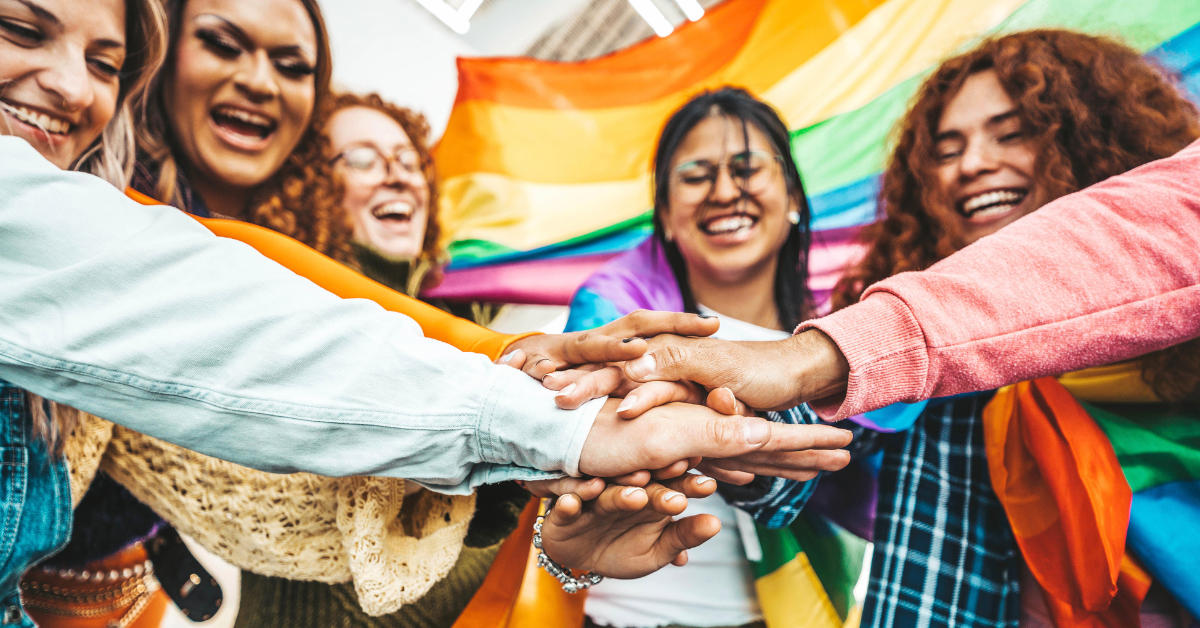
Joy can be an act of resistance.
With states across the country passing legislation that seeks to silence or erase LGBTQ+ contributions to the classroom and playing field, we know how heavy this moment feels for many LGBTQ+ youth, families, and educators. We also know that joy is an act of resistance. Community, connection, and, importantly, fun, are essential to maintaining the resilience needed to create real change. You, your children, and your community members are not alone, and even in the most challenging times, tapping into the power of joy is possible!
Explore the ideas below to get the party started.
Gender and Sexuality Alliances (GSA)
What is a GSA?
A GSA is a student-led group that brings together LGBTQ+ youth and their allies to create a supportive community and address challenges they face in school. Originally designed as safe spaces for LGBTQ+ students, GSAs have grown into dynamic groups that promote social change and advance crucial conversations. For LGBTQ+ parents, helping to establish or support a GSA is a meaningful way to ensure that your child—and others—have a space where they feel accepted and empowered. It’s also an opportunity to engage with your child’s school, build stronger connections with the community, and advocate for a more inclusive environment where all families can thrive.
Did you know?
Research from the Centers for Disease Control (CDC) links the presence of GSAs to positive mental and physical health outcomes for all students! By starting or participating in GSAs, youth experience an increased sense of purpose, self-esteem, and agency as well as reduced risk of experiencing violence.
Starting a GSA
First, determine whether your school already has one that you can participate in. The GSA Network provides a map of registered GSAs that are searchable by location.
If you discover that your school doesn’t already have a GSA, there’s no time like the present to start one!
- Explore your school’s guidelines. Look at the school’s handbook and search through their website to determine what the rules and processes are for starting a student group or club. This will help you determine next steps!
- Recruit a caring and affirming faculty advisor. In many instances, faculty advisors are required for any new student group. They’re also key to setting the atmosphere of the group and advocating for the needs of the group with the administration.
- Inform the administration about your plans. Don’t get too far into the planning process without communicating with administrators, who can be instrumental in advocating for the group with teachers, parent groups, community members, and the school board. If you run into opposition to your plans, understand that you have a legal right to form a GSA under the Federal Equal Access Act. In addition to making this legal right clear, you might want to invite the faculty advisor to advocate on your behalf. If you’re continuing to run into issues with the administration, the GSA Network can help you file a complaint.
- Plan and hold your first meeting! As you plan your first meeting, consider:
- Meeting somewhere safe and accessible,
- Promoting the meeting through flyers, social media, school newsletters, and word-of-mouth,
- Supplies you’ll need,
- Discussion topics
Depending on the climate of your school and community, you might face hostility or harassment as you meet and promote your club. Fortunately, there are ways to address these behaviors, and — in addition to providing a number of other resources to registered GSAs — the GSA Network has great tips for helping you navigate these challenges!
While you review the GSA Network’s resources, take a few seconds to register your group, if you haven’t already.

Know your rights: Forming a GSA
Courts have consistently ruled that GSAs are protected by the Equal Access Act, a federal law that prohibits schools with extracurricular student groups from discriminating against any group based on their viewpoint. If you experience opposition to the founding or meeting of your GSA, make sure your administration knows your GSA is legally protected.
If they still do not comply with the law after being informed, they are violating the Equal Access Act. We recommend filing a complaint via the same process as filing a Title IX complaint, which you can learn about at our Title IX resource.
Other inclusive community spaces and activities
There are also many events and activities that parents can lead for the school community within or outside of your school’s GSA. Consider the following ideas for creating inclusive spaces and building connection with other parents and students!
Banned Books Week Read-Alouds
Banned Books Week occurs annually in September and provides a great opportunity for highlighting the importance of free and open access to information. Using the official Banned Books Week resources, or creating your own, you can host events like a Banned Books Picnic in your local park for parents, teachers, and students to gather and read aloud from books that have been challenged or banned. Families can bring blankets and snacks, and take turns reading excerpts from LGBTQ+ inclusive books that celebrate diversity.
You can also print the Banned Books Week posters and bookmarks to hang or hand out at nearby coffee shops, post about the week to social media, and find other ways to spread the word in your community!
Inclusive sports teams and events
Sports are an important place for youth to learn life lessons about teamwork, dedication, and community. Yet, LGBTQ+ athletes are often implicitly and explicitly excluded from participating in sports — with some states even considering legislation that prohibits the ability of trans youth to participate on teams that align with their gender identity.
As a parent, you can encourage schools, teams, local LGBTQ+ sports organizations, and community leagues to foster inclusivity and create events where all students feel welcome. This might look like a Pride Sports Day, featuring activities like a fun-run, or special tournaments.
Community theater performances and workshops
If schools are reluctant to take on LGBTQ+ themes in their school plays, literature syllabi, or drama departments, parents can organize community performances and after-school theatre workshops that celebrate diverse and queer stories. Work with your local community center or an outdoor venue to host it.
LGBTQ+ movie nights
Youth deserve to see themselves reflected on stage and on screen! Hosting an outdoor movie night for students and families that showcase films about LGBTQ+ topics, acceptance, or allyship can be easy — all you need is a space and projector! You might also consider including time for discussion afterwards so students can reflect on what they learned.
Alternative “Alt” Prom
For high school-aged youth, rules, dress codes, and expectations around prom might make the traditional event feel unsafe or unwelcoming. “Alternative proms” are dances hosted by families, community centers, and LGBTQ+ organizations that allow youth to show up as their authentic selves, celebrate, and make new friends.
Team work makes the dream work!
You don’t have to do this work alone! If you’re struggling to garner the support of your school, research nearby LGBTQ+ community centers. These organizations exist to support their local and regional communities in creating events just like the ones noted above. They might be able to provide you with a space to gather, supplies and financial resources, volunteers, and marketing support.
Find local LGBTQ+ groups near you with CenterLink.
Bridge the gap
Forming connection and community with other parents involves authentic relationship building, frequently across various intersecting identities. It’s all too easy to become wrapped up in our own issues and forget that other people are also struggling. To become better allies and advocates, we must prioritize active support, education, and solidarity across various identities.
It’s all connected
Many of the anti-LGBTQ+ sentiments we see from policymakers today are also connected to issues of race, disability, class, and other identities.
For example, the recent wave of legislation censoring classrooms began with attempts to ban schools from teaching about the history of race relations in America. Anti-LGBTQ+ groups like Moms for Liberty got their start by advocating against the COVID-19 measures schools put in place to people with vulnerable health conditions.
The writer Kimberle Crenshaw has coined the word “intersectionality” to describe how various intersecting identities and inequities affect our lives. When we say that school advocacy and allyship should be “intersectional,” we mean:
- Consider what goes into making a school safe for everyone. Often, if a school is not safe for LGBTQ+ people, it also isn’t the safest environment for BIPOC people, low-income people, and people with disabilities. It is our responsibility as members of the community to identify things like unequitable discipline processes and unequal access for students with special needs. Standing up against these things makes for safer schools for all students.
- Avoid comparing or conflating your struggles with anyone else. There’s no need to figure out who has it worse or why one issue is more important than another. Those are just distractions from our shared beliefs and values. We are all working towards the same goal: A future where all youth can learn and grow in environments that celebrate, support, and protect them.
- Share your personal experience with other parents so that they can also learn to be better allies. Sometimes it’s frustrating to always have to explain the challenges your family faces in school. But all of us benefit from hearing the stories of other people in our community, as it helps us to see the full picture, understand the issues at stake, and feel empowered to create change.
Explore our website to view additional resources for advocating in the classroom, including tips on how to start a conversation with your school’s administrators and concrete ways you can use your story to advocate for inclusive schools at the local, state, and national level.

Nikhil Vashee (They/Them)
Director of Education Law and Policy, Senior Policy Counsel
This information was prepared and distributed by Family Equality.
info@familyequality.org | www.familyequality.org
Family Equality exists to create a world where everyone can experience the unconditional love, safety, and belonging of family. Our mission is to ensure that everyone has the freedom to find, form, and sustain their families by advancing equality for the lesbian, gay, bisexual, transgender, and queer (LGBTQ+) community.
